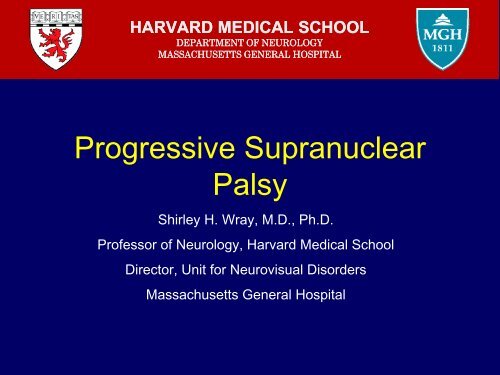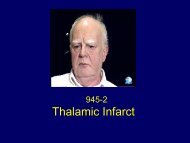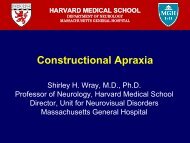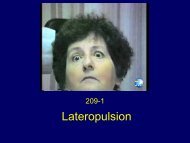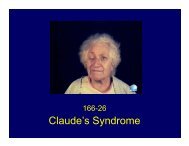Progressive Supranuclear Palsy
Progressive Supranuclear Palsy
Progressive Supranuclear Palsy
You also want an ePaper? Increase the reach of your titles
YUMPU automatically turns print PDFs into web optimized ePapers that Google loves.
HARVARD MEDICAL SCHOOL<br />
DEPARTMENT OF NEUROLOGY<br />
MASSACHUSETTS GENERAL HOSPITAL<br />
<strong>Progressive</strong> <strong>Supranuclear</strong><br />
<strong>Palsy</strong><br />
Shirley H. Wray, M.D., Ph.D.<br />
Professor of Neurology, Harvard Medical School<br />
Director, Unit for Neurovisual Disorders<br />
Massachusetts General Hospital
Criteria for Dx PSP<br />
Gradually progressive disorder<br />
Onset at age 40 years old or later<br />
Vertical supranuclear palsy<br />
Slowing of vertical saccades<br />
Postural instability with falls in the first<br />
year of disease onset
Supportive Criteria for Dx PSP<br />
Symmetric akinesia or rigidity<br />
Abnormal neck posture, especially<br />
retrocollis<br />
Poor or absent response of parkinsonism<br />
to levodopa therapy<br />
Early dysphagia and dysarthria<br />
Early onset of cognitive impairment,<br />
including at least 2 of these: apathy,<br />
decreased verbal fluency, impaired<br />
abstract reasoning, and utilization<br />
behavior
Clinical Features of PSP<br />
Slow vertical saccades, especially down, with a<br />
preserved range of movement, may be the first<br />
sign of the disorder; later, loss of vertical<br />
saccades and quick phases<br />
Horizontal saccades become slow and<br />
hypometric<br />
Disruption of steady gaze by horizontal saccadic<br />
intrusions (square-wave jerks)<br />
Impaired smooth pursuit, vertically (reduced<br />
range) and horizontally (with catch-up saccades)
Clinical Features of PSP<br />
Smooth eye-head tracking may be<br />
relatively preserved, especially vertically<br />
Preservation of vestibulo-ocular reflex<br />
Horizontal disconjugacy suggesting INO<br />
Loss of convergence<br />
Ultimately, all eye movements may be lost,<br />
but vestibular movements are the last to<br />
go
Clinical Features of PSP<br />
Eyelid disorders: delay in lid opening, lid<br />
lag, repetitive blinking in response to<br />
flashlight stimulus (failure to habituate),<br />
blepharospasm<br />
Tonic head deviation opposite to direction<br />
of body rotation (vestibulocollic reflex)<br />
Inability to clap just three times (applause<br />
sign)<br />
Leigh RJ, Zee DS. Diagnosis of Central Disorders of Ocular Motility. Chpt 12: 598-<br />
718. The Neurology of Eye Movements, Fourth Edition. Oxford University Press,<br />
NY, 2006.
Neuroimaging<br />
Figure 1: Sagittal T2-weighted MR in another patient with PSP shows the tectal plate is<br />
markedly thinned and atrophic.<br />
Courtesy Anne Osborn, MD.
Figure 2. Single photon emission tomography (PET) scan of a<br />
patient with PSP demonstrating frontal lobe hypoperfusion.
Figure 3. PET in a patient with PSP. Showing area of<br />
hypoperfusion (blue).
Pathology<br />
Figure 4: PSP_pale locus ceruleus<br />
Figure 5: PSP_pale substantia nigra
Pathology<br />
Figure 6: PSP-the-globose Tangle
Pathology<br />
Figure 7: PSP-tau-globose-tangle<br />
Figure 8: PSP-tau-tufted
Tauopathies: Clinical Diseases<br />
Alzheimer’s disease<br />
Dementia pugilistica<br />
Guam ALS/PD<br />
Pick disease<br />
Argyrophilic grain<br />
disease<br />
Nieman-Pick, type C<br />
SSPE<br />
PSP<br />
MSA<br />
Corticobasoganglionic<br />
degeneration<br />
FTDP-17<br />
Postencephalatic PD<br />
Autosomal recessive<br />
PD
References<br />
Freidman DI, Jankovic, J, McCrary III JA.<br />
Neuro-ophthalmic findings in progressive<br />
supranuclear palsy. J Clin Neuroophthalmol.<br />
1992 Jun; 12(2):104-109.<br />
Growden JH, Rossor MN. The Dementias.<br />
Blue Books of Practical Neurology.<br />
Butterworth-Heinemann 1998; vol 19.
Richardson JC, Steele J, Oszewski J.<br />
<strong>Supranuclear</strong> ophthalmoplegia, pseudobulbar<br />
palsy, nuchal dystonia and dementia. A clinical<br />
report on eight cases of heterogenous system<br />
degeneration. Trans Am Neurol Assoc. 1963;<br />
88:25-29.<br />
Stanford PM, Halliday GM, Brooks WS, Kwok<br />
JBJ, Storey CE, Creasey H, Morris JGL, Fulham<br />
MJ, Schofield PR. <strong>Progressive</strong> supranuclear<br />
palsy pathology caused by a novel silent<br />
mutation in exon 10 of the tau gene: explanation<br />
of the disease phenotype caused by tau gene<br />
mutations. Brain 2000; 123(Pt 5): 880-893.
http://www.library.med.utah.edu/NOVEL


